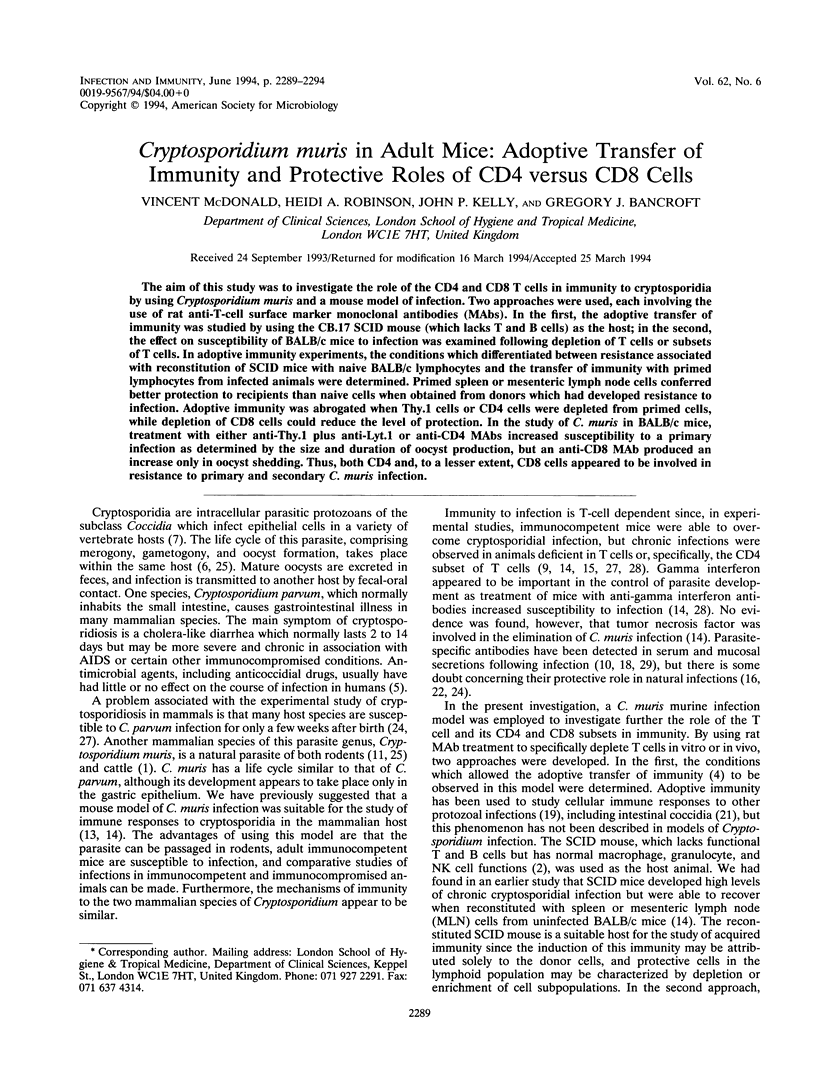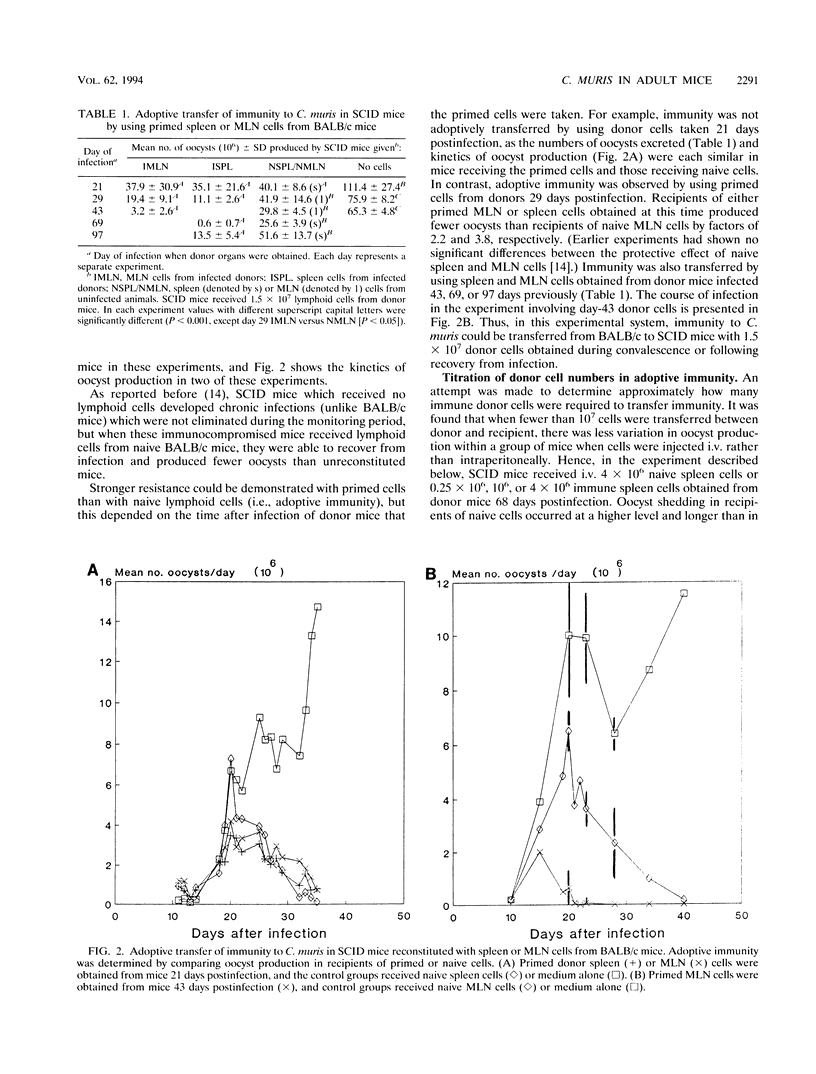Abstract
The aim of this study was to investigate the role of the CD4 and CD8 T cells in immunity to cryptosporidia by using Cryptosporidium muris and a mouse model of infection. Two approaches were used, each involving the use of rat anti-T-cell surface marker monoclonal antibodies (MAbs). In the first, the adoptive transfer of immunity was studied by using the CB.17 SCID mouse (which lacks T and B cells) as the host; in the second, the effect on susceptibility of BALB/c mice to infection was examined following depletion of T cells or subsets of T cells. In adoptive immunity experiments, the conditions which differentiated between resistance associated with reconstitution of SCID mice with naive BALB/c lymphocytes and the transfer of immunity with primed lymphocytes from infected animals were determined. Primed spleen or mesenteric lymph node cells conferred better protection to recipients than naive cells when obtained from donors which had developed resistance to infection. Adoptive immunity was abrogated when Thy.1 cells or CD4 cells were depleted from primed cells, while depletion of CD8 cells could reduce the level of protection. In the study of C. muris in BALB/c mice, treatment with either anti-Thy.1 plus anti-Lyt.1 or anti-CD4 MAbs increased susceptibility to a primary infection as determined by the size and duration of oocyst production, but an anti-CD8 MAb produced an increase only in oocyst shedding. Thus, both CD4 and, to a lesser extent, CD8 cells appeared to be involved in resistance to primary and secondary C. muris infection.
Full text
PDF





Selected References
These references are in PubMed. This may not be the complete list of references from this article.
- Bosma G. C., Custer R. P., Bosma M. J. A severe combined immunodeficiency mutation in the mouse. Nature. 1983 Feb 10;301(5900):527–530. doi: 10.1038/301527a0. [DOI] [PubMed] [Google Scholar]
- Cobbold S. P., Jayasuriya A., Nash A., Prospero T. D., Waldmann H. Therapy with monoclonal antibodies by elimination of T-cell subsets in vivo. Nature. 1984 Dec 6;312(5994):548–551. doi: 10.1038/312548a0. [DOI] [PubMed] [Google Scholar]
- Current W. L., Garcia L. S. Cryptosporidiosis. Clin Microbiol Rev. 1991 Jul;4(3):325–358. doi: 10.1128/cmr.4.3.325. [DOI] [PMC free article] [PubMed] [Google Scholar]
- Current W. L., Reese N. C. A comparison of endogenous development of three isolates of Cryptosporidium in suckling mice. J Protozool. 1986 Feb;33(1):98–108. doi: 10.1111/j.1550-7408.1986.tb05567.x. [DOI] [PubMed] [Google Scholar]
- Fayer R., Ungar B. L. Cryptosporidium spp. and cryptosporidiosis. Microbiol Rev. 1986 Dec;50(4):458–483. doi: 10.1128/mr.50.4.458-483.1986. [DOI] [PMC free article] [PubMed] [Google Scholar]
- Gomez Morales M. A., Pozio E., Croppo G. P. Detection of Cryptosporidium circulating antigens in human and calf sera. J Protozool. 1991 Nov-Dec;38(6):182S–183S. [PubMed] [Google Scholar]
- Harp J. A., Whitmire W. M. Cryptosporidium parvum infection in mice: inability of lymphoid cells or culture supernatants to transfer protection from resistant adults to susceptible infants. J Parasitol. 1991 Feb;77(1):170–172. [PubMed] [Google Scholar]
- Heine J., Moon H. W., Woodmansee D. B. Persistent Cryptosporidium infection in congenitally athymic (nude) mice. Infect Immun. 1984 Mar;43(3):856–859. doi: 10.1128/iai.43.3.856-859.1984. [DOI] [PMC free article] [PubMed] [Google Scholar]
- Iseki M., Maekawa T., Moriya K., Uni S., Takada S. Infectivity of Cryptosporidium muris (strain RN 66) in various laboratory animals. Parasitol Res. 1989;75(3):218–222. doi: 10.1007/BF00931279. [DOI] [PubMed] [Google Scholar]
- McDonald V., Deer R., Uni S., Iseki M., Bancroft G. J. Immune responses to Cryptosporidium muris and Cryptosporidium parvum in adult immunocompetent or immunocompromised (nude and SCID) mice. Infect Immun. 1992 Aug;60(8):3325–3331. doi: 10.1128/iai.60.8.3325-3331.1992. [DOI] [PMC free article] [PubMed] [Google Scholar]
- Mead J. R., Arrowood M. J., Healey M. C., Sidwell R. W. Cryptosporidial infections in SCID mice reconstituted with human or murine lymphocytes. J Protozool. 1991 Nov-Dec;38(6):59S–61S. [PubMed] [Google Scholar]
- Moon H. W., Woodmansee D. B., Harp J. A., Abel S., Ungar B. L. Lacteal immunity to enteric cryptosporidiosis in mice: immune dams do not protect their suckling pups. Infect Immun. 1988 Mar;56(3):649–653. doi: 10.1128/iai.56.3.649-653.1988. [DOI] [PMC free article] [PubMed] [Google Scholar]
- Peeters J. E., Villacorta I., Vanopdenbosch E., Vandergheynst D., Naciri M., Ares-Mazás E., Yvoré P. Cryptosporidium parvum in calves: kinetics and immunoblot analysis of specific serum and local antibody responses (immunoglobulin A [IgA], IgG, and IgM) after natural and experimental infections. Infect Immun. 1992 Jun;60(6):2309–2316. doi: 10.1128/iai.60.6.2309-2316.1992. [DOI] [PMC free article] [PubMed] [Google Scholar]
- Roberts J. A., Tracey-Patte P. Adoptive transfer of immunity to Plasmodium berghei. J Protozool. 1969 Nov;16(4):728–730. doi: 10.1111/j.1550-7408.1969.tb02334.x. [DOI] [PubMed] [Google Scholar]
- Rose M. E., Hesketh P., Wakelin D. Immune control of murine coccidiosis: CD4+ and CD8+ T lymphocytes contribute differentially in resistance to primary and secondary infections. Parasitology. 1992 Dec;105(Pt 3):349–354. doi: 10.1017/s0031182000074515. [DOI] [PubMed] [Google Scholar]
- Rose M. E., Wakelin D., Joysey H. S., Hesketh P. Immunity to coccidiosis: adoptive transfer in NIH mice challenged with Eimeria vermiformis. Parasite Immunol. 1988 Jan;10(1):59–69. doi: 10.1111/j.1365-3024.1988.tb00203.x. [DOI] [PubMed] [Google Scholar]
- Saxon A., Weinstein W. Oral administration of bovine colostrum anti-cryptosporidia antibody fails to alter the course of human cryptosporidiosis. J Parasitol. 1987 Apr;73(2):413–415. [PubMed] [Google Scholar]
- Sherwood D., Angus K. W., Snodgrass D. R., Tzipori S. Experimental cryptosporidiosis in laboratory mice. Infect Immun. 1982 Nov;38(2):471–475. doi: 10.1128/iai.38.2.471-475.1982. [DOI] [PMC free article] [PubMed] [Google Scholar]
- Taghi-Kilani R., Sekla L., Hayglass K. T. The role of humoral immunity in Cryptosporidium spp. infection. Studies with B cell-depleted mice. J Immunol. 1990 Sep 1;145(5):1571–1576. [PubMed] [Google Scholar]
- Tzipori S. Cryptosporidiosis in perspective. Adv Parasitol. 1988;27:63–129. doi: 10.1016/S0065-308X(08)60353-X. [DOI] [PMC free article] [PubMed] [Google Scholar]
- Ungar B. L., Burris J. A., Quinn C. A., Finkelman F. D. New mouse models for chronic Cryptosporidium infection in immunodeficient hosts. Infect Immun. 1990 Apr;58(4):961–969. doi: 10.1128/iai.58.4.961-969.1990. [DOI] [PMC free article] [PubMed] [Google Scholar]
- Ungar B. L., Kao T. C., Burris J. A., Finkelman F. D. Cryptosporidium infection in an adult mouse model. Independent roles for IFN-gamma and CD4+ T lymphocytes in protective immunity. J Immunol. 1991 Aug 1;147(3):1014–1022. [PubMed] [Google Scholar]
- Williams R. O., Burden D. J. Measurement of class specific antibody against cryptosporidium in serum and faeces from experimentally infected calves. Res Vet Sci. 1987 Sep;43(2):264–265. [PubMed] [Google Scholar]


